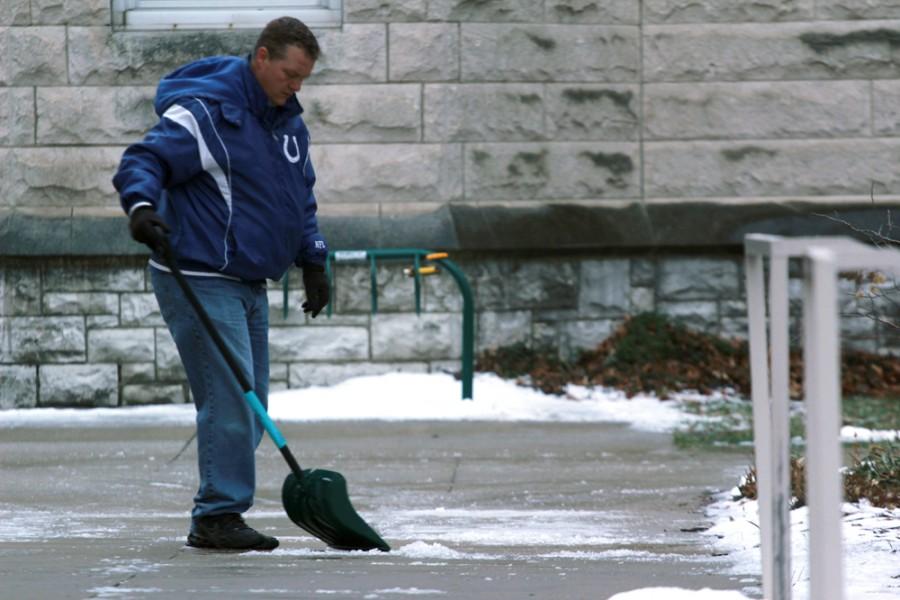Professor advises winter weather preparation
Robert Wells, a building service worker in Blair Hall, shovels ice off of the sidewalks Monday outside of Blair Hall. Wells started shoveling ice around 4 a.m. on Monday morning. Wells said that workers go and shovel ice around two or three times a day during this weather.
January 12, 2015
A quarter inch of ice coating the roads Monday morning suggested this winter would be no warmer than usual.
Still, Cameron Craig, a geography professor, expects he will look out at sea of shorts and flip flops mid-winter in his class this semester.
Each spring semester Craig surveys his class for weather-appropriate attire, and without fail, at least one pair of sandals makes its way into his classroom in winter conditions.
“And then I ask, ‘who’s got shorts on?’ and of course there’s the ‘machos’ that think they need to wear them to show their masculinity, and that can actually be dangerous,” he said. “The younger generations don’t think about what they’re supposed to be wearing.”
Pale or red, cold ears that tingle as they begin to warm are the early stages of frostbite, which if ignored, may develop into blisters within 24 hour. In severe cases, it can develop into tissue-damaging frostbite, according to the National Weather Service.
When your body begins to shiver or feel chilled, it is irresponsible not to respond Craig said, noting that becoming too cold may even result in a stroke.
“What happens physiologically is the blood is slowly being pulled in from the extremities to protect the core. So blood thickens in your limbs and clots can form,” he said. “Then when you warm back up, the red blood will go back up to the limbs and could dislodge that clot, and that goes around your body and comes around to the brain.”
Equally important as dressing appropriately, is making sure your vehicle is prepared for the winter, Brad Oyer, a Charleston police officer said.
If a driver’s car does begin to spin, Oyer suggested “steering your way out of it, letting off the gas and slowing down.”
“It’s always good to have a little bit of food with you, blankets, heat pads, extra pair of boots, and a snow shovel to get yourself out,” he said.
Similarly, Craig suggested keeping a bag of cat litter nearby to spread for traction if a vehicle becomes stuck in the snow.
“If there’s a huge snow (storm) and you get stuck, place a fluorescent-type ribbon on your antenna, and if you don’t have an antenna, place it somewhere high enough where it can be seen,” he said.
Both men agree, however, it is important to consider the risk of traveling in winter weather before getting in the car.
“It isn’t really worth the risk of going where we want to go,” Oyer said. “In this mobile society we want to be able to go anywhere we want to go. Speed and icy conditions don’t mix very well.”
Craig recommends checking the Illinois Department of Transportation website before leaving home. A map on the site color-codes main roads according to their conditions.
“If it’s green, then you’re in good shape,” he said. Yellow usually means 50 percent ice (or) snow cover. If highways and secondary roads are red it’s 75 percent, and higher ice and snow cover.”
Wet and slick conditions may require warming and clearing your car, as well as slowing to a safe speed, which is why drivers should allow themselves more time to travel to their destination, Craig said.
“If you have doubts about your safety—if that is the first thing that comes to mind, then stay home,” he said. “When the university website says students should use their own discretion, either leave early or decide, ‘I’m going to need to stay home today because I don’t want to risk it.’”
Craig said Monday’s slick roads and sidewalks are consistent with typical early-January weather conditions, and where predicted correctly by meteorologists ahead of time.
“We are in the battle zone that can be ice but we’ve had ice in Chicago as far North as Wisconsin,” he said. “The reason why we got a lot of ice is because the low pressure is to our south.”
Craig also warned that temperatures earlier in the day might feel deceivingly warm.
When it comes down to winter weather, when driving or walking, people need to take it slower.
“The ice was starting to melt (early Monday). That temperature has been dropping all day and now that thawed ice is ice again,” he said.
Katie Smith can be reached at 581-2812 or DENeic@gmail.com.





![[Thumbnail] Eastern's Old Main was quiet Thursday morning while educators who had left the office to strike picketed outside.](https://www.dailyeasternnews.com/wp-content/uploads/2025/04/Strike_01_LT_O-800x1200.jpg)









![[Thumbnail Edition] Senior Foward Macy McGlone, getsw the ball and gets the point during the first half of the game aginst Western Illinois University,, Eastern Illinois University Lost to Western Illinois University Thursday March 6 20205, 78-75 EIU lost making it the end of their season](https://www.dailyeasternnews.com/wp-content/uploads/2025/03/WBB_OVC_03_O-1-e1743361637111-1200x614.jpg)

























































